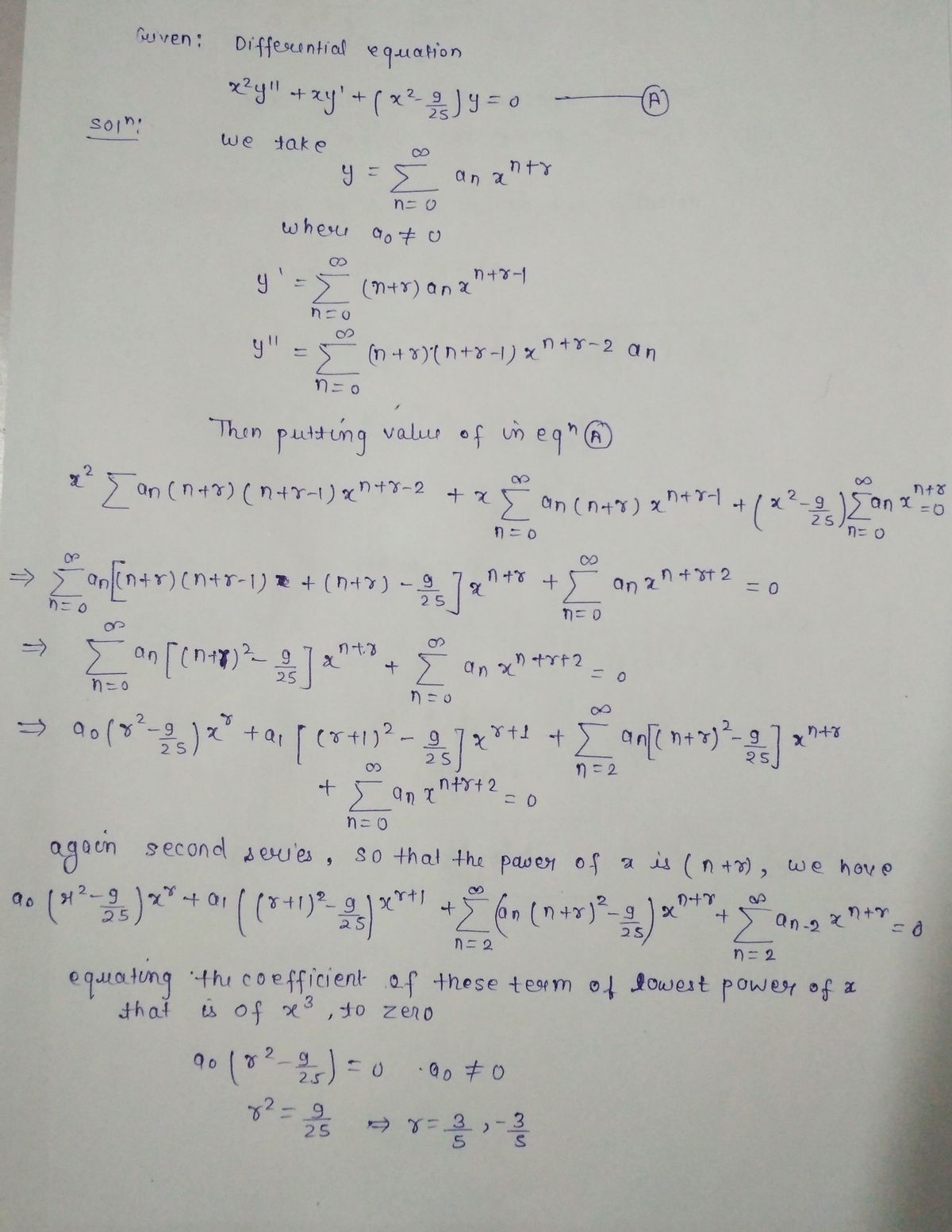The point x = 0 is a regular singular point of the given differential equation. 9 + (x² - 12/13 ) y = 0 Show that the indicial roots r of the singularity do not differ by an integer. (List the indicial roots below as a comma-separated list.) r= x²y" + xy' + Use the method of Frobenius to obtain two linearly independent series solutions about x = 0. Form the general solution on (0, ∞). 25 Oy=C₁x-3/5(1. 25x² + ...) + C₂x³/5(1 - 3x² + x4 + 3328 8 448 9 x4 448 9 3328 - 5 32 + Need Help? Read It 9 3328 25 x4 + 448 + Oy = C₁x-3/5(1 3 32 O y = C₁x - 3/5(1-x². ...) + C₂x³/5(1. Oy = C₁x 3/5(1-x²- ..) + C₂x³/5(1- 3328 3 9 Oy=C₁x-3/5(1-²+2x4+...) + ₂x³/5(1-1/2+²+ 328 +²+...) 8 32 + + 448 25+... 9 x4 + 448 ...) + C₂x³/5(1-32x2² Watch It + 3x2+ 32 52+ 32 + x4 + 25 x4 +
The point x = 0 is a regular singular point of the given differential equation. 9 + (x² - 12/13 ) y = 0 Show that the indicial roots r of the singularity do not differ by an integer. (List the indicial roots below as a comma-separated list.) r= x²y" + xy' + Use the method of Frobenius to obtain two linearly independent series solutions about x = 0. Form the general solution on (0, ∞). 25 Oy=C₁x-3/5(1. 25x² + ...) + C₂x³/5(1 - 3x² + x4 + 3328 8 448 9 x4 448 9 3328 - 5 32 + Need Help? Read It 9 3328 25 x4 + 448 + Oy = C₁x-3/5(1 3 32 O y = C₁x - 3/5(1-x². ...) + C₂x³/5(1. Oy = C₁x 3/5(1-x²- ..) + C₂x³/5(1- 3328 3 9 Oy=C₁x-3/5(1-²+2x4+...) + ₂x³/5(1-1/2+²+ 328 +²+...) 8 32 + + 448 25+... 9 x4 + 448 ...) + C₂x³/5(1-32x2² Watch It + 3x2+ 32 52+ 32 + x4 + 25 x4 +
Advanced Engineering Mathematics
10th Edition
ISBN:9780470458365
Author:Erwin Kreyszig
Publisher:Erwin Kreyszig
Chapter2: Second-order Linear Odes
Section: Chapter Questions
Problem 1RQ
Related questions
Question
100%
Discret maths, please type the final answer clearly thanks
![The point \( x = 0 \) is a regular singular point of the given differential equation:
\[
x^2 y'' + xy' + \left( x^2 - \frac{9}{25} \right) y = 0
\]
Show that the indicial roots \( r \) of the singularity do not differ by an integer. (List the indicial roots below as a comma-separated list.)
\[
r = \quad
\]
Use the method of Frobenius to obtain two linearly independent series solutions about \( x = 0 \). Form the general solution on \( (0, \infty) \).
\[
\begin{align*}
&\circ \quad y = C_1 x^{3/5} \left( 1 - \frac{5}{32} x^2 + \frac{25}{3328} x^4 + \cdots \right) + C_2 x^{3/5} \left( 1 - \frac{5}{8} x^2 + \frac{25}{448} x^4 + \cdots \right) \\
&\circ \quad y = C_1 x^{3/5} \left( 1 - \frac{32}{3} x^2 + \frac{9}{3328} x^4 + \cdots \right) + C_2 x^{3/5} \left( 1 - \frac{5}{32} x^2 + \frac{9}{448} x^4 + \cdots \right) \\
&\circ \quad y = C_1 x^{3/5} \left( 1 - \frac{5}{32} x^2 + \frac{25}{448} x^4 + \cdots \right) + C_2 x^{3/5} \left( 1 - \frac{3}{32} x^2 + \frac{9}{448} x^4 + \cdots \right) \\
&\circ \quad y = C_1 x^{3/5} \left( 1 - \frac{8}{5} x^2 + \frac{25}{448} x^4 + \cdots \right) + C_2 x^{3/5} \left( 1 -](/v2/_next/image?url=https%3A%2F%2Fcontent.bartleby.com%2Fqna-images%2Fquestion%2Fe462800b-ac16-4590-bafb-82d68c005ec5%2Fcb99ed9f-c74d-40fb-84a1-cf0640ab58a0%2Fmzr9qh_processed.jpeg&w=3840&q=75)
Transcribed Image Text:The point \( x = 0 \) is a regular singular point of the given differential equation:
\[
x^2 y'' + xy' + \left( x^2 - \frac{9}{25} \right) y = 0
\]
Show that the indicial roots \( r \) of the singularity do not differ by an integer. (List the indicial roots below as a comma-separated list.)
\[
r = \quad
\]
Use the method of Frobenius to obtain two linearly independent series solutions about \( x = 0 \). Form the general solution on \( (0, \infty) \).
\[
\begin{align*}
&\circ \quad y = C_1 x^{3/5} \left( 1 - \frac{5}{32} x^2 + \frac{25}{3328} x^4 + \cdots \right) + C_2 x^{3/5} \left( 1 - \frac{5}{8} x^2 + \frac{25}{448} x^4 + \cdots \right) \\
&\circ \quad y = C_1 x^{3/5} \left( 1 - \frac{32}{3} x^2 + \frac{9}{3328} x^4 + \cdots \right) + C_2 x^{3/5} \left( 1 - \frac{5}{32} x^2 + \frac{9}{448} x^4 + \cdots \right) \\
&\circ \quad y = C_1 x^{3/5} \left( 1 - \frac{5}{32} x^2 + \frac{25}{448} x^4 + \cdots \right) + C_2 x^{3/5} \left( 1 - \frac{3}{32} x^2 + \frac{9}{448} x^4 + \cdots \right) \\
&\circ \quad y = C_1 x^{3/5} \left( 1 - \frac{8}{5} x^2 + \frac{25}{448} x^4 + \cdots \right) + C_2 x^{3/5} \left( 1 -
Expert Solution
Step 1

Step by step
Solved in 3 steps with 3 images

Recommended textbooks for you

Advanced Engineering Mathematics
Advanced Math
ISBN:
9780470458365
Author:
Erwin Kreyszig
Publisher:
Wiley, John & Sons, Incorporated

Numerical Methods for Engineers
Advanced Math
ISBN:
9780073397924
Author:
Steven C. Chapra Dr., Raymond P. Canale
Publisher:
McGraw-Hill Education

Introductory Mathematics for Engineering Applicat…
Advanced Math
ISBN:
9781118141809
Author:
Nathan Klingbeil
Publisher:
WILEY

Advanced Engineering Mathematics
Advanced Math
ISBN:
9780470458365
Author:
Erwin Kreyszig
Publisher:
Wiley, John & Sons, Incorporated

Numerical Methods for Engineers
Advanced Math
ISBN:
9780073397924
Author:
Steven C. Chapra Dr., Raymond P. Canale
Publisher:
McGraw-Hill Education

Introductory Mathematics for Engineering Applicat…
Advanced Math
ISBN:
9781118141809
Author:
Nathan Klingbeil
Publisher:
WILEY

Mathematics For Machine Technology
Advanced Math
ISBN:
9781337798310
Author:
Peterson, John.
Publisher:
Cengage Learning,

